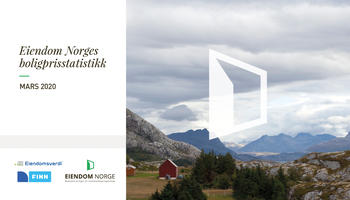
Rise in house prices in January
House prices rose by 3 per cent in January 2023. Adjusted for seasonal variations, prices were unchanged.
Over the past 12 months, house prices in Norway have fallen by 0.3 per cent.
The average price for a home in Norway was NOK 4,367,609 at the end of January.
- House prices rose in January as normal for the month, also known as the January effect, says CEO of Eiendom Norge, Henning Lauridsen.
- Last year the January effect was particularly strong due to the "disposal law effect". Many wanted to sell before the changes to the Disposal Act came into force and it took longer to prepare homes for sale. This resulted in a low offer and the strongest January rise in history. This year, the development is as normal for the month, which the seasonally adjusted prices show.
- Without the easing in the lending regulations from 1 January, the price development and volume would probably have been much weaker, says Lauridsen.
Many homes sold
In January, 6,887 homes were sold in Norway, which is 27.2 per cent more than the corresponding month in 2022.
In January, 6,219 homes were put up for sale in Norway, which is 9 per cent more than in the same month in 2022.
- Many homes were sold in January, especially compared to January in 2022. The sales volume this year is on par with the time before the pandemic, says Lauridsen.
It took an average of 52 days to sell a home in January, up from 47 days in December. Bodø with Fauske has the shortest sales time with 35 days. Tromsø had the longest sales time with 78 days.
- The sales time is increasing slightly, but it is still possible to sell a property quickly in Norway, he says.
Weaker development going forward
Stavanger and its surroundings had the strongest seasonally adjusted price development in January, where prices rose by 1 per cent.
Trondheim had the weakest seasonally adjusted price development, with a seasonally adjusted decrease of 1.3 per cent.
Kristiansand has seen the strongest development over the past 12 months, with an increase of 4.3 per cent, followed by Stavanger and surroundings at 3.6 per cent and Ålesund and surroundings at 1.9 per cent.
The weakest development over the past 12 months is Follo with a decrease of 3.1 per cent, followed by Asker and Bærum with a decrease of 2.8 per cent and Romerike with a decrease of 2.6 per cent.
- House price developments in January were somewhat stronger in Eastern Norway, Southern Norway and South Western Norway than in the rest of the country. In line with our forecast for 2023, published in December, we expect a weak development in house prices in the coming months, says Lauridsen.
- Without the easing in the lending regulations from New Year, the development in the housing market would probably have been weak. Among other things, the reliefs involve a significant improvement in the purchasing power of households with normal incomes in the housing market. It was wise of Finance Minister Trygve Slagsvold Vedum (Sp) to listen to us in this case instead of the Financial Supervisory Authority, concludes Lauridsen.






